| Pineapple Pests | ||
|---|---|---|
| Back
to Pineapple Page 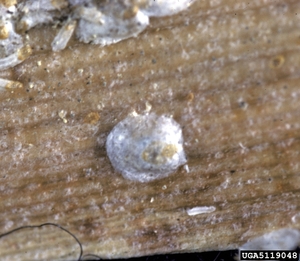 Fig. 1  Pineapple scale Diaspis bromeliae (Kerner) 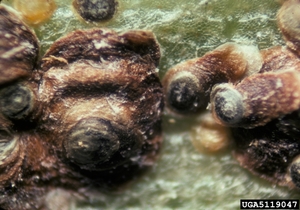 Fig. 2  Brown pineapple scale Melanaspis bromiliae (Leonardi) 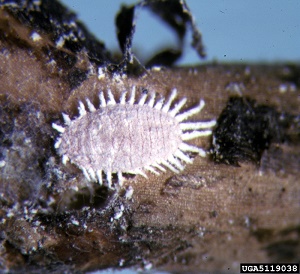 Fig. 3  Pineapple mealybug (Dysmicoccus brevipes) (Cockerell) 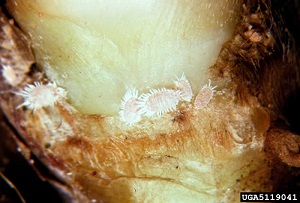 Fig. 4  Pineapple mealybug D. brevipes nymph(s) 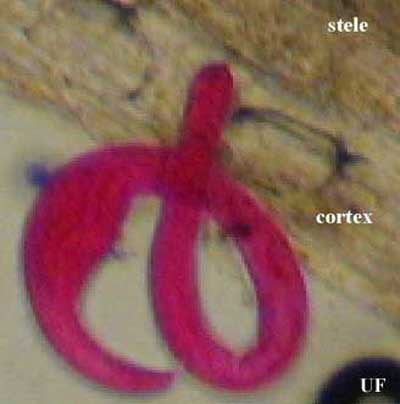 Fig. 5 Young female of reniform nematode, Rotylenchulus reniformis, with swollen body
|
Mealybugs
may
attack the leaves and lateral, shallow roots, weakening the plant and
decreasing fruit production. Ants commonly "farm" mealybugs and scales
by protecting them from natural predators and moving them to new
feeding sites. Controlling ants will decrease the likelihood of
mealybug infestations. Scales attack the leaves of pineapple plants,
which weakens the plant. To prevent scale infestations, use clean soil
media to start new plants and inspect plants frequently. 1 Pineapple scale Diaspis bromeliae (Kerner) Brown Pineapple Scale Melanaspis bromiliae (Leonardi) Pineapple Mealybug Dysmicoccus brevipes (Cockerell) Dysmicoccus brevipes, commonly called the pineapple mealybug (Fig. 3) or more specifically the pink pineapple mealybug, is a worldwide pest of pineapple crops and a minor pest of many other crops. Its importance as a crop pest of pineapple is tied strongly to its ability to transmit Pineapple mealybug wilt-associated virus to pineapples. 2 The pineapple mealybug forms colonies on the lower stem and roots of pineapple plants, just above ground level. They are less commonly found feeding on the leaves, fruit, and blossom cups. 2 Direct feeding damages the fruit, causing chlorotic areas (areas that cannot produce enough chlorophyll), rotted bottoms, and mealybug stripe (streaks of discoloration with underlying tissue collapse). Feeding by the pineapple mealybug can weaken the plant, increasing susceptibility to other pests and diseases. Black spot, caused by a fungus, is reported on pineapple fed upon by mealybugs. Black sooty mold and other molds commonly grow in areas exposed to a buildup of honeydew produced by mealybugs. 2 Further Reading Pineapple Mealybug, Dysmicoccus brevipes (Cockerell), University of Florida pdf Nematodes Several nematodes may cause significant injury to pineapple roots including root knot (Meloidogyne spp.) and reniform (Rotylenchulus reniformis) nematodes. Symptoms include plant decline, stunted development and reduced fruit production. Plant only vigorous plant material. If possible inspect the roots for signs of nematode feeding before planting, and discard planting material with signs of infestation. The best control is not to introduce nematode-infested soil or plant material into the pineapple planting area. 1 Further Reading Reniform Nematode, Rotylenchulus reniformis Lindford and Oliveira, University of Florida pdf |
|
| Bibliography 1 Crane, Jonathan. "Pineapple Growing in the Florida Home Landscape." Horticultural Sciences Dept, UF/IFAS Extension, Original pub. 1975, Re-written Oct. 2006, Revised Nov. 2016, Reviewed Dec. 2019, AskIFAS, edis.ifas.ufl.edu/MG055. Accessed 3 Mar. 2017, 13 Apr. 2020. 2 Egelie, Ashley A. and Jennifer L. Gillett-Kaufman. "Pineapple Mealybug, Dysmicoccus brevipes (Cockerell) (Insecta: Hemiptera: Pseudococcidae)." Entomology and Nematology Department, UF/IFAS Extension, EENY635, Original pub. Oct. 2015, Rev. Dec. 2021, AskIFAS, edis.ifas.ufl.edu/in1106. Accessed 19 Dec. 2016, 4 Jan. 2019, 4 Jan. 2024. Photographs Fig. 1,2 Pineapple Scale Adult(s). "Diaspis bromeliae (Kerner) and Brown Pineapple Scale Adult(s) Melanaspis bromiliae (Leonardi)." United States National Collection of Scale Insects Photographs Archive, USDA Agricultural Research Service, 2006, (CC BY-NC 3.0 US), bugwood.org. Accessed 19 Dec. 2016. Fig. 3 "Pineapple Mealybug Dysmicoccus brevipes Adult(s), Pineapple Mealybug Dysmicoccus brevipes Nymph(s)." United States National Collection of Scale Insects Photographs Archive, USDA Agricultural Research Service, 2006, (CC BY-NC 3.0 US), bugwood.org. Accessed 28 Jan. 2014. Fig. 4 "Pineapple Mealybug Dysmicoccus brevipes Nymph(s)." United States National Collection of Scale Insects Photographs Archive, USDA Agricultural Research Service, 2006, (CC BY-NC 3.0 US), bugwood.org. Accessed 19 Dec. 2016. Fig. 5 Wang, Koon-Hui. "Young female of reniform nematode, Rotylenchulus reniformis Linford & Oliveira, with swollen body." Entomology and Nematology Dept., UF/IFAS Extension, edis.ifas.ufl.edu. Accessed 19 Dec. 2016. Published 28 Jan. 2014 LR. Last update 4 Jan. 2024 LR | ||